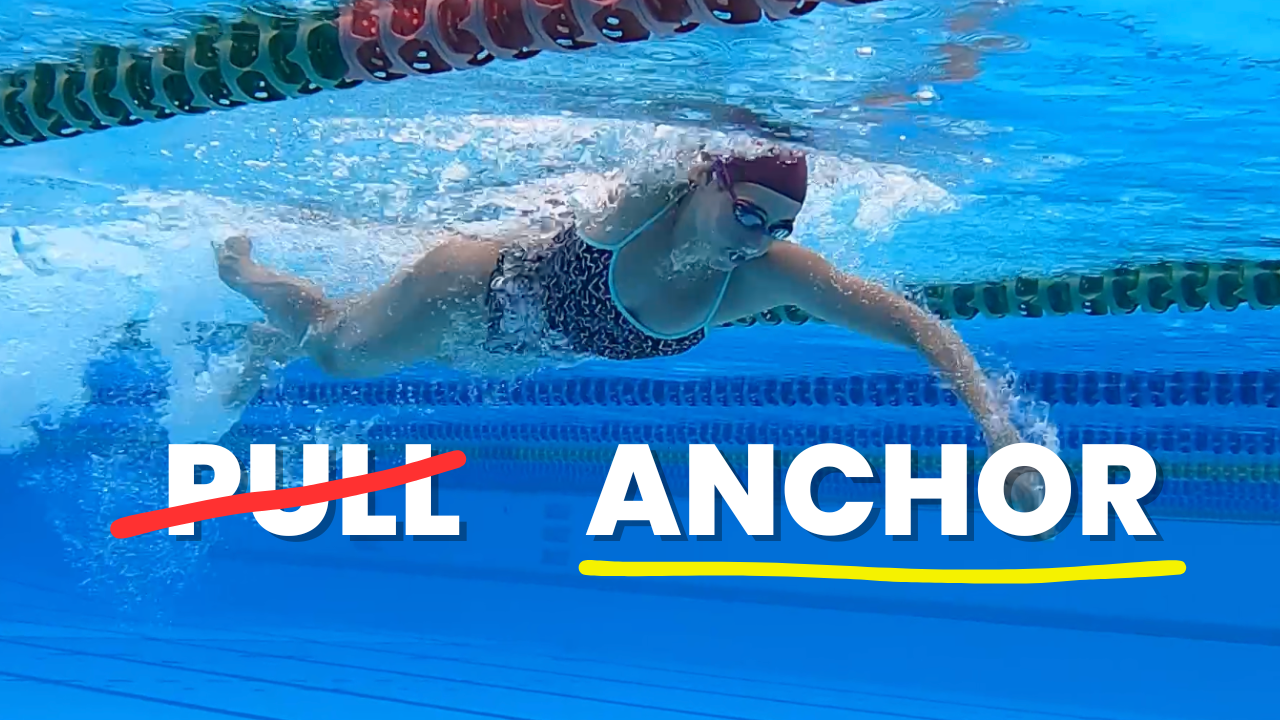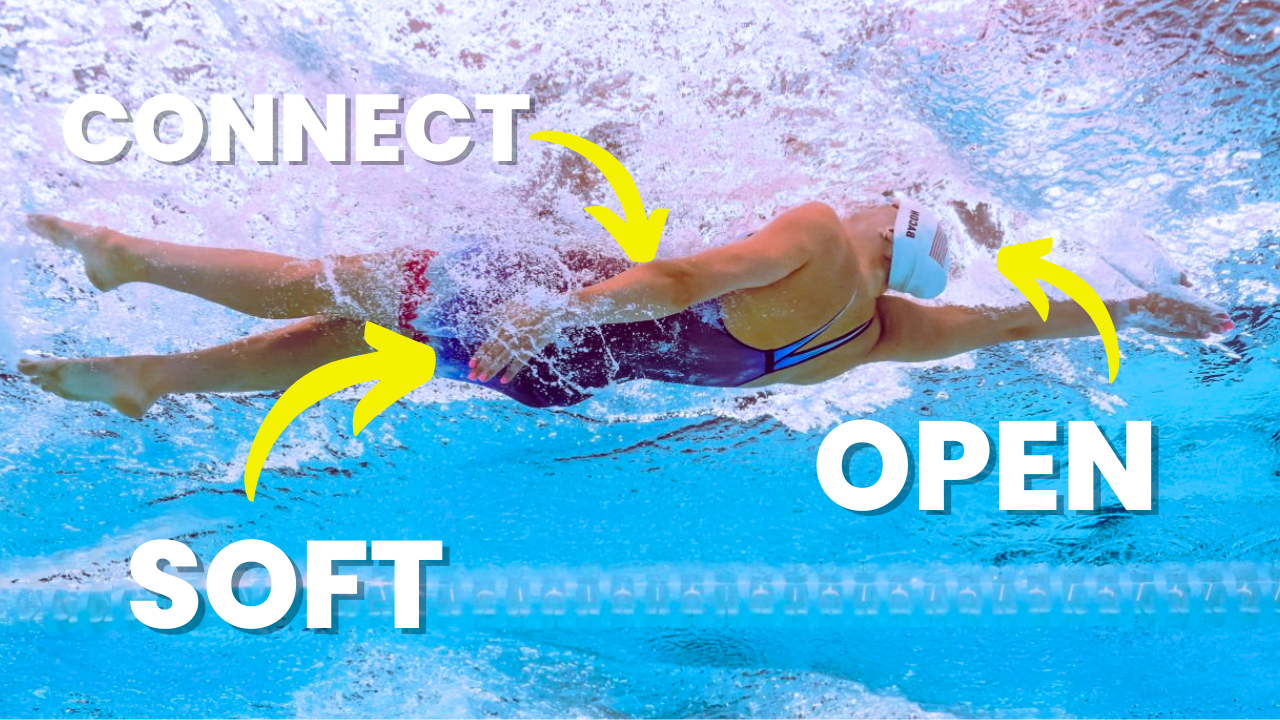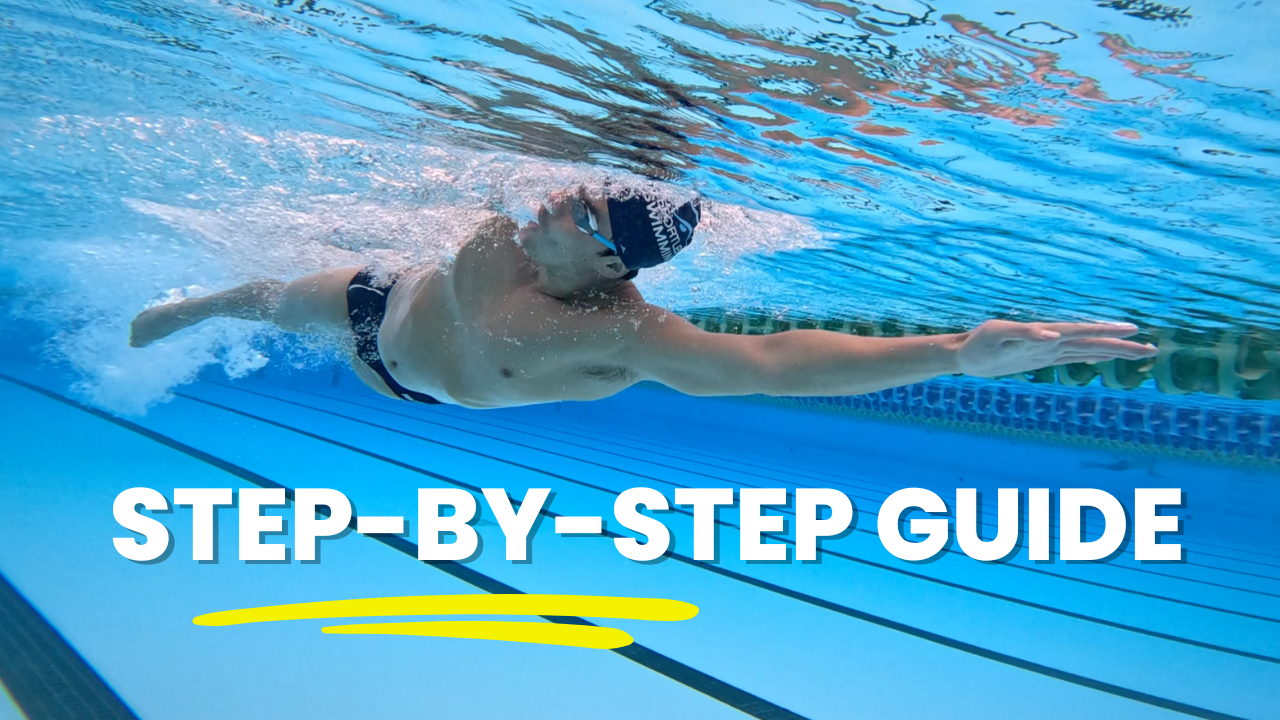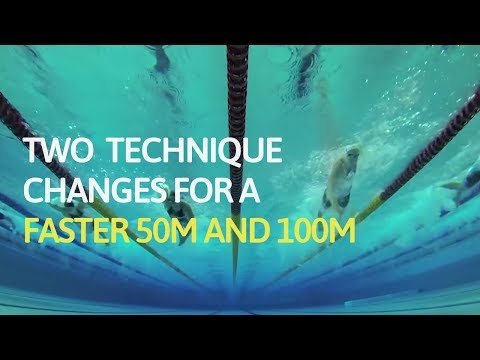In this episode, we have a swimmer who’s stuck at 1:50/100m pace for his 400m and more swims. His 100m PB is 1:31/100m. We cover why he needs to: 1. Enter further in front of the head 2. Increase his stroke rate 3. Go deeper with his catch and pull 4. Exit closer to the hip
Transcription:
I think he’s better off going slightly deeper with it. Opening up that angle a little bit to get somewhere around that sort of range. Now we call this position the power diamond. If you had both arms in that position, it kind of looks like a diamond, front on, as you’re about to pass under the shoulders there. The reason why you see most elite swimmers in that sort of range is because-
Hi, Brenton here. Welcome to Feedback Friday. This is where we analyze someone’s stroke. We give feedback on things that will make them faster and more efficient over the coming months. And we recommend what drills they can do to help improve all of these things. Now if you, not a subscriber already, hit that notification bell and subscribe to the videos. We make two to three videos a week, all about helping you swim faster.
Now in this episode, we’re looking at someone whose best time for a hundred meters is a 1:31, and across a 400 the pace is about 1:50 per hundred. So looking through here, the first thing that I can see is with the legs, the inner thighs, the knees are actually a little bit too wide, so there’s not enough tautness and engagement through the midsection of the body. It’s more obvious when you look from the front here. And actually, we’ll see it quite a bit just in this next shot here. If the inner thighs and knees are really wide, then two things happen there. Firstly, it just means that the legs end up being out a little bit wider, which can create a bit of extra drag there. But the biggest thing that that does is there’s usually not enough tautness through the core and not enough tautness and engagement through the glutes.
So looking side on there, you can actually see how the legs and the inner thighs just tend to sort of drift apart there. So from a drag perspective, it’s going to slow him down. But really from an overall control and stability perspective through the midsection of the body, that’s going to be compromised. So what we want to try and do there is just suck the tummy in like you’re drawing that belly button into the spine. Keep the inner thighs and the knees a little bit closer together. So not quite as wide apart in that direction. So yes, the knees will move apart up and down when you’re kicking away from each other. But in terms of the width, they usually don’t come too far apart there. Yeah, they’ll come apart but not a whole lot.
So in order to to do that, he’ll need to suck the tummy in and squeeze the bum cheeks together a bit, engage the glutes slightly and that will keep this midsection really straight. A little bit of tension through there just to hold this smaller shape. And that would be the very first thing, because without that, then it kind of makes the other things hard to do. So you want to start with the right things and work on them in the right order.
Now if you’re not sure of the right order for this stuff, have a look at our Five Core Principles. We have a video on YouTube, I’ll link to that in our description below. That covers the progression that we recommend people follow.
Now the next thing I’m looking at here is the hand entry, so you can see that the hand entry is quite close to the head, so we’d be looking to enter slightly further forwards and it’s more evident from above here. If you have a look as he comes over. Okay, nice with that recovery, elbows pointing to the sky, that’s good. Now that hand entry’s just in front of the head there. What we normally like to aim for is having it go slightly further forwards. So just the last bit of reach and extension happens under the water instead of most of it. Reason for that is if you enter too close to the head and all the extension happens in the water, it’s going to slow you down. It’s a little bit too much, too much of that arm coming forwards and pressing through or moving through in the water, which creates quite a bit of drag there. So if you can just have the last part of the reach happen in the water, then it will minimize that drag that gets created. So that would be the second thing we’d be aiming to do.
Now for him to do it, he’s probably going to have to feel like he’s going a long way out. It’s one of those things you need to exaggerate to change. That’s what I’ve found from coaching a lot of swimmers at our clinics and camps is, there are things that you need to really overdo to change and my guess is that’s going to be one of them for him. So that would be the second thing.
Now where he gets to is really good. Nice starting catch position. So where he goes to begin the catch, we call it the starting catch position, you’ve got fingers below wrists, wrists below the elbow, and it’s in this very slight downwards angle. And the rotation through the hips and the upper body as well looks really good. He’s between that 35 to 45-degree range through the hips and through the shoulders. So really nice rotation side to side there with both arms. So none of that really needs to change.
So, first of all, we’ve got keeping the inner thighs and knees a little bit closer together. Secondly, we’ve got entering further out in front. The next thing I’d then be looking to do is actually going a little bit deeper with the right hand. Now you can see he gets some pretty good catch positions, his left arm. Excellent, really good position here. Nice high elbow catch. Now the way we define what’s a high elbow catch, that’s the start of the catch. That’s the end of the catch. Now in at the end of the catch, if we draw a line from the shoulder to the fingertips, if that elbow is above that straight line, that’s a high elbow catch. And the reason we want to be in that position, hand and forearms mostly pressing back behind you and that’s going to be really effective at generating that propulsion to move you forwards.
Now, this is a great position. Here’s in that high elbow catch. Probably goes a little bit shallow from here, here to here. And the reason I say that is what we want to usually try and do and you see this most of the time with elite distance swimmers is the shoulder, elbow and hand will roughly align, one, two, three. Everything’s lined up underneath there instead of having the hand out in front. Now the difference there as you can see is if everything aligned, it’s a lot more surface area pressing backward. Where it currently is, that’s somewhat pressing down there. So for him to be able to do that, he’s just basically got to go deeper with the hands. So at the moment, I think he’s just moving a little bit too shallow too early, which is creating that position there.
So, first of all, he’s going to have to go deeper, and secondly, he’s probably going to have to go through some drills like the YMCA drill progression that we have in our video membership. You’ve probably seen the first of those drills, the YMCA drill in some of our videos and I’ll put a video of that above there. Now that’s a great drill just to make sure he gets that position and adjust the depth. Same thing on this right hand side. Really nice starting catch position gets a pretty good position here. He does get to that high elbow position just, but I think he goes a bit shallow as you can see there. And it’s more evident when you look front on. So here we go, right hand coming in extending forwards, setting up the catch nicely, but goes quite shallow.
And another way you can tell are you going too deep or too shallow, as you are about to pass underneath the shoulder there, we generally like to measure the angle of the arm. It can be a good indicator as to if you’re in the right position. So the ideal angle with most of them is 100 to 120. You can see that the angle is about 89 degrees, so around 90 degrees. That just means there’s a bit too much bend in the elbow. So he’s probably too shallow.
So what we might want to do there, look, he can keep his arm where it currently is, but I think he’s better off going slightly deeper with it, opening up that angle a little bit to get somewhere around that sort of range. Now we call this position the power diamond. So if you had both arms in that position, it kind of looks like a diamond front on as you’re about to pass under the shoulders there. The reason why you see most elite swimmers in that sort of range is because that’s when they are really able to get into their lats. They’re able to use their lats really well to pull through, and those stronger muscles through the shoulder and the back.
If you are either too deep or if you are too shallow, then quite often it’s using different muscles in the upper traps. You can be a little bit hunched over, which is just generally isn’t quite as strong as using your lats there. So for that we just want him to go a little bit deeper and again that YMCA drill can just help him do that.
And now probably a part of that too, you can see how it goes a little bit shallow there, and then the hand actually sort of presses out instead of coming into the body. So if we look at the path of the hand, what we generally want to do is have it start in line with the shoulder, come out a little bit wider than the shoulder as you go through this out sweep and then have it come in towards the hip here. Now you can just see this part, how the hand actually goes away from the body there. So from here to here, that last part of the stroke, he’ll be getting some propulsion from it.
But in terms of power, it’s quite a bit weaker, and quite a bit less effective in terms of that direction of the force if he’s out where he currently is. So we just want him to, first of all, go deeper and then bring that hand coming in towards the body a little bit more. And that’s a much more direct path and that’s going to be a lot more effective in this one, same thing, just a little bit shallow. You can see that angle as he’s about to pass underneath the shot. He’s right on a hundred, but I’d be looking to go down a little bit deeper here. And then the same thing, just finishing a little bit wide of the hip. So bring that hand in towards the hip there and finish off a bit closer.
So like if you’re sitting down, you put your hands next to your hips and you go to push yourself up, it’s pretty easy to do that. Get your hands 10, 15 centimeters away from your hips and it’s that little bit harder, just because of the position that your arms in. So that’s what I’d recommend with that. And again, the YMCA drill, it’s got those four key positions.
The last position is the exit of the hand. And with that drill, you’ll want your hands kind of on your hips or just past it with the palms facing back behind you. So that’s why that drill can be really good for just adjusting that position there. So that’d be the next thing we’d be looking to do.
And after that, what he may be able to do as well, just looking through here, the next thing we’d be looking at stroke rate. So the current stroke rate, let’s just have a look at this. So I’m just going to measure or just calculate what his approximate stroke rate is. So you’ve got 27.5 there as he comes through. I’m just looking at the time. I said 27.5, 29.7, all right. So he’s a little bit under 60s, around sort of 55, 56 strokes per minute there. Now, my general rule of thumb for most people, not everyone, but most people, when they’re racing or if they’re going say 400, 800 sorts of time trial, you generally want that stroke rate to be 60 strokes per minute or above. So for him to swim faster, that’s another lever that he’s got, another tool that he’s got in his toolbox in order to swim faster there.
So a couple of things that will help him swim faster. Getting that stroke rate up is going to make a difference. So how can he do that? There’s a couple. There’s probably a little bit too much of a pause out in front with some of the strokes there. So if we look at, say this right hand, there’s a point in time where the hand doesn’t really move. It’s about 0.3, 0.4 of a second. So we call that, it’s like a dead spot. It’s like a pause where the hand doesn’t move at all. You want to keep that lead hand in motion all the time. Doesn’t mean it needs to rush down into the catch, but you don’t want it to stop completely. So always keep that lead hand in motion. Yep. It’ll slow down out there, but then it will keep rolling through. It’s not going to completely stop. So I’d get rid of that complete pause on the right and on the left hand side a little bit.
The other thing that will help with that too, look, you can probably recover a little bit quicker. So the timing. I’m just going to cut to this view here. If have a look over here, the recovery is somewhat slow. It’s quite quick on the entry and you want some hand speed on entry, but just over the top, bring it over a little bit quicker than that. You can shorten the cycle of the stroke by increasing the recovery speed. So he doesn’t even really need to pull through any faster underneath in order to increase his stroke rate. What he can do is bring the hand over a little bit quicker, cut out some of that dead spot out in front of the stroke, and already you can bring that stroke right up to 65 to 70 strokes a minute without really putting in much extra effort at all. And it’s probably going to be pretty much the same amount of effort and it’s going to be quite sustainable for him. So that’s the progression that I’d be looking to follow there.
So just to recap there, we’ve got keeping the inner thighs and knees a bit closer together. So suck the tummy in, belly button into the spine, engage the glutes like you’re squeezing your bum cheeks together lightly. You can do some drills with that. You can even put a kick board between your legs like you’d use as a pull buoy, and that can help teach you that same sort of engagement there.
Second thing that we want to do is enter a little bit further out in front of the head. So we don’t want to enter too close. You don’t want this triangle shape to be that sharp. You just want it to be in that sort of range. That’s the second thing.
Then we looked at going a little bit deeper in the catch and pull. As you can see he just ends up going a little bit too shallow. And I think that’s shallowness of this part of the stroke here is probably causing him to stay a bit wide. So after he goes a bit deeper, get those hands in next to the hips. The YMCA progression drills are the best ones for that. It hits on each of those positions and just helps you retrain that motor pattern. So they’re the drills I’d recommend.
And then after that just looking at increasing stroke rate as another way that you can swim faster. So currently around 55, 56 strokes per minute. If this his, say, 400-meter pace, over time there’s no reason why he couldn’t bring that up to 65 to 70 strokes a minute without really any extra effort. And that’s also going to help him bring that 1:50 pace down to 1:45 and 1:40 and onwards from there. And we’ve had a lot of swimmers at clinics and at camps who have been able to do that by following that same order and progression. We’ve had thousands of different swimmers do clinics and camps and I get emails regularly about people who have taken 10, 15 seconds off their hundred-meter pace following this same progression.
So if you’re interested in getting something like this done for yourself, we offer this in a number of ways. We’ve got clinics that we run around Australia. We have a number of camps. We’ve got some in Thailand, Hawaii, and in Australia as well. You can check those on the website. And we also do online coaching where you can send in videos often as you like. And I do the analysis for swimmer, so that’s our online coaching membership. Check that out below. There are links in the description. Thanks for watching. I’ll be back next week. Let me know in the comments what you think of this analysis, and one of the things that you got out of it and if there are any other suggestions that you’d have for this swimmer. Thanks for watching. See you next week.









